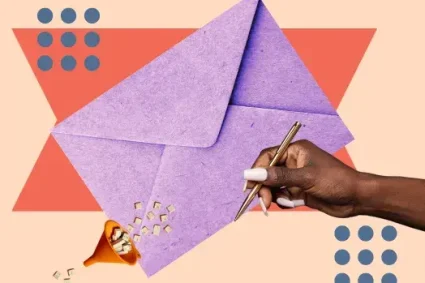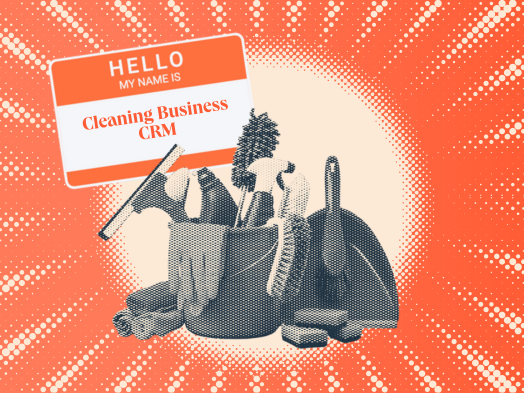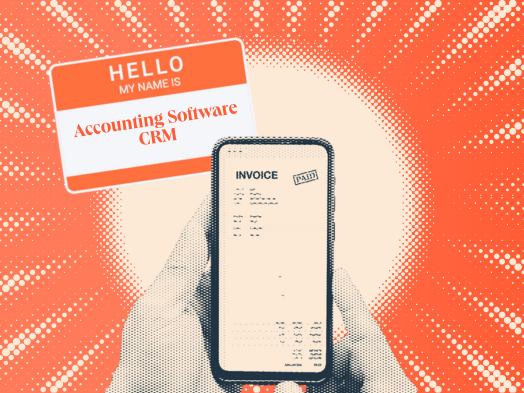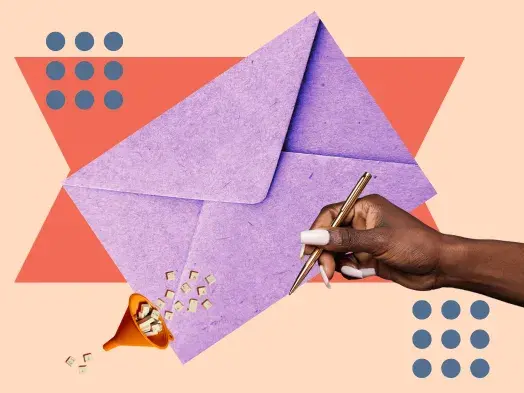
In my early sales days, I would spend hours preparing for a meeting, doing research, crafting the perfect pitch, and rehearsing objections. But, I didn’t realize the real test often comes after the call ends. It wasn’t in what I said, but in what I did next.
I assumed a good meeting guaranteed a next step. I underestimated how busy, distracted, and overloaded decision-makers really are. That’s when I learned a simple truth: The follow-up is the close. It’s where you clarify the win and prove you’re the kind of part ner who follows through, not just shows up.
ner who follows through, not just shows up.
Since then, I’ve treated every follow-up email like part two of the pitch. Not a generic “Thanks again,” but a well-timed message that adds context, anticipates objections, and makes next steps frictionless. Because in sales, just like in life, it’s not about what you say. It’s about what you do next.
Let’s get into it.
Table of Contents
- Follow-Up Email Subject Lines
- How to Send a Follow-Up Email After Networking
- When to Follow Up After a Meeting
- How to Write a Thank You Email After a Meeting
- Thank You Email After Meeting Tips
- Follow-Up Email Templates
- Thank You for Meeting With Me Email Templates
- The Importance of Sending a Thank You Email After a Meeting
- Follow-Up Thank You Email Mistakes to Avoid
Follow-Up Email Subject Lines
Before we look at the follow-up email templates below, I wanted to go over some strong subject lines for your emails. I like to remember that the subject line is the first thing recipients see when they glance at their inbox, so it needs to grab their attention and make them want to open my message.
Below are some of my most successful subject lines for follow-up emails.
1. “Circling back with two ideas I didn’t get to share on our call”
Why it works: This subject line plays into unfinished business — a psychological hook that creates curiosity and keeps the door open. It also signals that you’re someone who’s still thinking post-call, which most reps aren’t. In a world where follow-ups feel templated, this one feels alive.
How I use it: I send this within 24 to 48 hours of a call when I genuinely have insights I didn’t get to share. It doesn’t matter if it’s a framework, a story from a similar client, or even a new angle that clicked after the meeting. I’m not just recapping. I’m adding value.
2. “Re: Your hiring bottleneck — here’s a client example I mentioned”
Why it works: Personalized. Pain-based. Solution-oriented. This line taps directly into the emotional thread your prospect shared, without being dramatic. You’re showing that you listened, you understood the stakes, and you followed through with proof.
How I use it: When a client mentions a hiring challenge, ramp time issue, or team capacity concern, I follow up with a short story or Loom that shows how another company overcame it. I don’t give a full case study, but just enough for them to see what’s possible. Short. Specific. Strategic.
3. “Quick follow-up + a playbook I promised”
Why it works: The word “promised” hits differently. It builds credibility and taps into social psychology. We respond better to people who keep their word. This subject line doesn’t try too hard, but it delivers trust, clarity, and a subtle sense of anticipation.
How I use it: I always say on calls, “I’ll follow up with a short playbook on this.” This line lets me fulfill that without sounding like I’m just “checking in.” The email itself includes two to three slides, a short breakdown, or even a bullet-point summary. Nothing fancy — just real, usable thinking.
4. “Thanks for the honesty on churn, I’ve seen this before”
Why it works: Vulnerability opens doors. When a prospect shares something raw (like customer churn, missed targets, or internal conflict), acknowledging it with empathy, not urgency, builds depth. This line shows emotional intelligence, not just sales skill.
How I use it: I’ve sent this after conversations where the prospect lets their guard down. In the email, I don’t jump into a pitch. I relate. I offer a short observation from a past client. And then, I invite them into a no-pressure conversation. This is how trust begins.
5. “Following up on Tuesday — here’s the roadmap I’d build in your shoes”
Why it works: You’re stepping into their world, not pulling them into yours. This line positions you as someone who thinks like them, not someone trying to convince them. It’s also time-stamped (“Tuesday”), which grounds it in real momentum.
How I use it: Perfect for post-demo or exploratory calls. I break down the roadmap into three parts: Now, Next, and Later. It’s not just a proposal. It’s a strategic view that says, “Here’s how I’d tackle this if I had your problems and my tools.” That framing changes everything.
6. “Your words stuck with me, especially what you said about growth not solving broken systems”
Why it works: Quoting the prospect shows deep listening. But more than that, it makes your email feel like a reflection, not a pitch. Executives are used to people talking at them. This feels like someone thinking with them.
How I use it: I jot down strong phrases during calls, especially ones that feel like “truth bombs.” Later, I use those words to start the follow-up. It anchors the conversation in their language and makes the message feel tailored, not transactional.
7. “Our convo got me thinking: What if the real issue isn’t the pipeline, but the process?”
Why it works: This subject line triggers a strategic reframe. It’s not accusatory; it’s curious. And curiosity invites conversation. It also breaks the pattern of typical follow-ups by offering a new lens instead of pushing the same message.
How I use it: This approach is ideal when the prospect is fixated on a surface-level problem (like lead volume), but you sense the root issue is deeper (like poor qualification or low win rates). I pair this with a diagram, mental model, or bold opinion to earn a reply.
8. “Not just a summary — here’s what I’d do next if I were in your role”
Why it works: Executives don’t need another recap. They need direction. This line communicates ownership, perspective, and confidence — three things they’re subconsciously scanning for in every vendor. It says: I’m not here to chase. I’m here to contribute.
How I use it: After a great call, I’ll summarize key takeaways in bullet form. Then, I always include “If I were you, here’s what I’d do next.” This creates a consultative tone. I’m not asking them to buy. I’m showing them how to move.
9. “You asked about benchmarks — here’s what I’m seeing across the market”
Why it works: Buyers want to know what others like them are doing. This line positions you as a pattern-seeker, not a product-pusher. It promises market intel, not marketing fluff.
How I use it: I collect trends, metrics, and quotes from past clients, and share the ones most relevant to the person I’m emailing. I don’t just give averages. I give nuance. “Series A companies in health tech are seeing this, but fintech’s a different story…” That’s where trust is built.
10. “One last thing before your leadership sync: framing the ask”
Why it works: This line taps into timing and alignment. It’s perfect for that quiet space before a big internal meeting, when your prospect is prepping slides or arguments. You’re not being pushy. You’re being helpful. You’re equipping, not chasing.
How I use it: I use this when I know they’re pitching the idea to their CFO or board. I send them two to three bullet points on how to position the ROI, risks of inaction, and language to use when justifying the investment. That’s how you become a partner, not just a vendor.
How to Send a Follow-Up Email After Networking
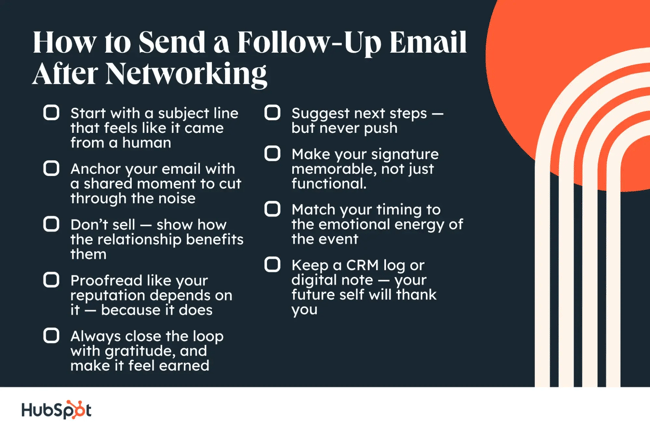
Step 1: Start with a subject line that feels like it came from a human, not a template.
Like I mentioned above, something I’ve learned after sending thousands of follow-up emails — the first thing that determines whether someone reads your message isn’t your clever body copy or thoughtful recap. It’s the subject line. That tiny little string of text is either a green light … or a brick wall.
And when you’re following up after networking, especially from an event where people met dozens of faces, your subject line needs to jog memory and spark interest immediately. I never go with “Nice to meet you” or “Great chatting” — they’re forgettable. Instead, I tie it to a moment (“From the AI panel yesterday — Diego”), a shared laugh (“The coffee line was worth it”), or even a bit of curiosity (“I had a crazy idea after our chat…”).
Find inspiration from my examples above or this list of 150+ subject lines, but whatever you do, make it personal and make it specific. Most importantly, make it feel like you’re a real human who wants to keep the conversation going, not a calendar reminder with a smiley face.
Step 2: Anchor your email with a shared moment to cut through the noise.
Whenever I follow up after a networking conversation, I always start with context. Why? Because no one remembers your face better than they remember how you made them feel.
If you can tie your email to a moment that triggered emotion — a surprising insight, a laugh, a powerful talk you both watched — you separate yourself from the dozens of generic follow-ups they’re about to ignore.
For example, I once followed up with a VP of sales after a SaaS growth event. Instead of “It was great meeting you,” I wrote, “I’ve been thinking about your comment during the AI roundtable — the part about replacing SDRs, not just augmenting them. You hit a nerve.”
He replied in four minutes.
People don’t want your resume in their inbox. They want a reason to remember you. So give them one.
Step 3: Don’t sell — show how the relationship benefits them.
This is where most people mess it up. They jump into a pitch. But here’s the thing: Nobody goes to a networking event hoping to get spammed the next day. They go hoping to meet people who help them solve problems, unlock insight, or grow their career.
So instead of writing “Let me tell you more about what we do,” I write something like, “You mentioned your reps are struggling to get meetings with CFOs — I’ve worked with a few teams who tackled that exact bottleneck. Happy to share what worked if helpful.”
Value upfront. No strings. That’s how trust starts. And the truth is, even if they’re not ready to buy, they’ll remember you as someone who understands them, which is exactly what gets you the meeting when the timing is right.
Step 4: Proofread like your reputation depends on it — because it does.
This one sounds basic, but it’s crucial. You can write the most emotionally intelligent, value-packed follow-up in the world … and if it’s riddled with typos, you’ll come across as rushed, careless, or transactional.
Here’s my rule: Before I hit send, I read it out loud. If anything sounds robotic, repetitive, or unclear, I change it. Tools like Grammarly help, sure. But your voice? That’s the final filter.
And if you really want to level up, tailor your tone to match theirs. If they were formal, stay sharp. If they joked around with you at the event, loosen up a bit. People notice when you mirror their style. It makes them feel safe.
Step 5: Always close the loop with gratitude, and make it feel earned.
Gratitude is currency in sales. But, a lazy “thanks again” doesn’t buy you much. Instead, I make it personal and specific.
“Thanks again for taking the time to unpack your GTM strategy with me. It gave me a totally new lens on what startups are getting wrong with intent data.”
That kind of thank-you shows them you were present. That you actually listened. And that you’re not just trying to close a deal, you’re building a relationship.
That’s what gets you invited to the next conversation, the private Slack group, or the inner circle.
Step 6: Suggest next steps — but never push.
Here’s my philosophy: curiosity over control.
If the connection is strong, the next step should feel natural. So, I don’t write, “Let’s book 30 minutes to explore synergies.” I write, “Not sure if it makes sense to jam further, but if you ever want to swap notes on outbound experiments or see how others are using AI agents in their funnel, I’m happy to open the playbook.”
Soft. Helpful. Open-ended. It respects their bandwidth while still giving them a clear door to walk through.
That’s how I’ve landed coffee with CMOs, partnerships with $100M+ companies, and podcast invites — all from simple, non-pushy follow-ups like that.
Step 7: Make your signature memorable, not just functional.
Your email signature isn’t just an afterthought. It’s a mini billboard for your personal brand.
Mine includes:
- A link to my LinkedIn.
- A Calendly link for quick access.
- A line like “Helping consultants book 10–20 qualified meetings/month with AI agents.”
- And sometimes, a short P.S. with something relevant, like a podcast episode, blog post, or success story.
It’s subtle, but powerful. It reinforces what I do, who I help, and how they can engage, without a single hard pitch. Every detail in your email should serve your narrative. Even the footer.
Pro tip: Allow your email recipients to book follow-up meetings on your calendar with you. HubSpot’s free meeting scheduler makes the process easy.
Step 8: Match your timing to the emotional energy of the event.
Timing isn’t just about the clock. It’s about the momentum.
I try to follow up within 24 hours while the conversation is still warm, but more importantly, while the emotional imprint is still strong. That sense of excitement. Curiosity. Openness.
Strike while the brain is still firing from that keynote or that spark of connection.
But if I know they’re flying home or decompressing after a three-day event? I wait 48 hours. Respect the bandwidth. Let the dust settle. Then drop a note that brings them back to that moment.
The right timing feels intuitive. And, it makes you stand out.
Step 9: Keep a CRM log or digital note — your future self will thank you.
One of the best habits I’ve developed is this: After every event, I log every meaningful conversation into a CRM or Notion board, even if no clear opportunity exists yet.
I write down:
- Where we met.
- What we talked about.
- Personal tidbits (kids, city, projects, etc.).
- What I promised to follow up with.
Why? Because 90% of sales is follow-up. And, 90% of follow-up is remembering things that most people forget. This small step compounds. Months later, when I reference their exact words or send a book they mentioned … it lands.
It’s not automation. It’s attention. That’s your edge.
Step 10: Don’t just follow up. Follow through.
The biggest mistake I see in networking is this: People send the thank-you email … and that’s it.
But, if you told them you’d share a resource? Send it. If you promised to introduce them to someone? Make the intro. If you said you’d check back in a few months? Put it in your calendar now.
Your follow-up email is the opening move, not the whole game. Real relationships are built over time, through consistent value, thoughtful touchpoints, and keeping your word even when no one’s watching.
This is how deals get done, doors open, and reputations are built.
And the truth is, the way you follow up says more about you than anything you said in the actual conversation.
So, don’t just send the email. Be the kind of person they want to hear from again.
When to Follow Up After a Meeting
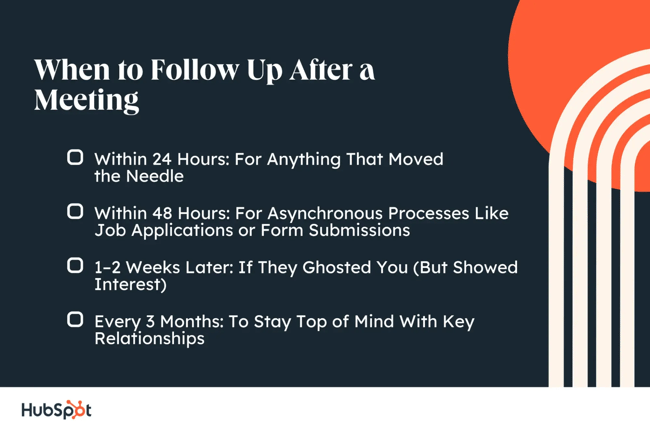
If there’s one thing I’ve learned over the years leading hundreds of sales calls, partner meetings, and investor pitches, it’s this: The timing of your follow-up isn’t just a courtesy. It’s part of the close.
I used to think following up “whenever I had time” was fine. But time after time, I’d watch warm leads go cold, relationships drift, and momentum fade — all because I didn’t show up at the right moment with the right message.
Let me break down how I approach follow-ups now, based on what’s worked in the field, not just in theory.
Within 24 Hours: For Anything That Moved the Needle
Whether it was a high-stakes sales pitch, a networking coffee that sparked synergy, or a discovery call that uncovered real pain points, I always follow up within 24 hours. Not “tomorrow or the next day.” The same day, if possible.
Why? Because clarity decays fast. And most buyers are juggling a dozen things. If you don’t follow up while the emotion, context, and urgency are fresh, you’re not just late — you’re forgettable.
I usually send a short, emotionally intelligent email that includes:
- A thank-you (always genuine, never robotic).
- A recap of their goals and what I heard.
- A clear CTA (book the next meeting, review the proposal, share internal feedback).
This works across the board: sales calls, client check-ins, strategic partnerships, even investor meetings. Respect their time by acting quickly. I’ve literally had C-level buyers reply, “Thanks for the speed — rare these days.”
Within 48 Hours: For Asynchronous Processes Like Job Applications or Form Submissions
If I’ve submitted something — an application, a form, a questionnaire — I wait about 48 hours before checking in. Not because I’m being passive. But because I know the internal process on their side takes a minute.
When I do follow up, I keep it warm and curious, not pushy. Something like:
“Just checking in on the [submission name] I sent over on Tuesday. Would love to hear your thoughts or next steps when you have a moment. Let me know if I can clarify anything.”
The tone here matters. People don’t owe us urgency, but they do appreciate professionalism and persistence. That balance builds trust.
1–2 Weeks Later: If They Ghosted You (But Showed Interest)
This one’s tricky, but real. I’ve had meetings that felt amazing … then radio silence.
Instead of jumping to assumptions or sounding passive-aggressive, I follow up with clarity and grace after a week or so. I acknowledge the delay with empathy, remind them what we discussed, and give them a low-pressure way to re-engage.
Here’s what I usually say:
“I know you’ve got a lot on your plate, and I totally understand if priorities shifted. Just wanted to circle back on our conversation about [insert benefit or next step]. Happy to pick things up whenever the timing feels right.”
Sometimes this gets no reply. Sometimes it leads to a deal I almost gave up on. But, it always preserves the relationship.
Every 3 Months: To Stay Top of Mind With Key Relationships
Not every meeting leads to a deal. But every relationship, if nurtured properly, can lead to long-term opportunities.
Every quarter, I make it a point to follow up with people I value, even if there’s no immediate agenda. I’ll send them an interesting article, give them a podcast I think they’d like, or just check in to see how things are going on their end.
It’s not about selling. It’s about staying relevant and human. And, I’ve closed some of my biggest deals years after the first “quick check-in” message.
Use Calendar Reminders or Sequences (Don’t Rely on Willpower)
When I started tracking my follow-ups like I tracked my pipeline, my close rate improved by at least 20%. I now use simple CRM reminders, or even Google Calendar, to schedule touchpoints based on meeting type.
You can automate parts of this, but never automate the tone. Your message should still feel handcrafted, personalized, and thoughtful.
How to Write a Thank You Email After a Meeting
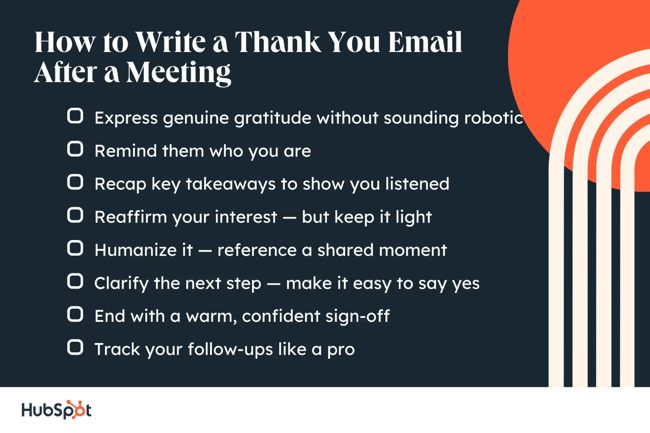
If there’s one thing I’ve learned in sales after hundreds of meetings, it’s this: What happens after the meeting often matters more than what happens in the meeting.
That short, thoughtful follow-up note can be the difference between momentum and missed opportunity. Over the years, I’ve refined how I write thank you emails to keep deals moving, relationships warm, and trust compounding. Below, I’ll walk you through exactly how I do it, step by step.
Step 1: Express genuine gratitude without sounding robotic.
Let’s be honest — we’ve all received those cold, copy-paste follow-ups: “Thanks for your time. Let me know if you have questions.” They feel flat because they are.
I always open with sincere gratitude, but I personalize it. I might say something like, “I know your schedule is packed, so I genuinely appreciate the 30 minutes you carved out today. The way you broke down [insert insight they shared] gave me a lot to think about.”
Be specific. Point out something they said that stuck with you. That signals you weren’t just present — you were paying attention.
Step 2: Remind them who you are (yes, even if you think they’ll remember).
I used to assume that after a great meeting, my name would be top of mind. It’s not. People have back-to-back calls and overflowing inboxes. I now always reintroduce myself in the first two lines.
For example, “It was great meeting earlier today — this is Diego, the sales consultant you spoke with about scaling outbound using AI agents.”
Quick, confident, and helpful. You’re anchoring the memory so they don’t have to dig through their inbox wondering, “Wait, who is this again?”
Step 3: Recap key takeaways to show you listened — and to align.
One of the most powerful follow-up habits I’ve developed is recapping the meeting in 3–5 bullet points. Not just for them, but for me. It’s how I make sure we’re actually on the same page. And when I do this, 9 times out of 10, I get replies like “Perfect recap — this matches my notes.”
You might say, “Here’s a quick summary of what we discussed, just to make sure I captured everything correctly…”
Then bullet out the key insights, needs, and next steps. It shows professionalism, reinforces clarity, and positions you as someone who takes ownership.
Step 4: Reaffirm your interest — but keep it light.
This isn’t the time to hard-pitch or sound desperate. Instead, I treat it as a soft re-commitment. Something like, “I’m genuinely excited about the potential of working together, especially after hearing about your challenges around lead quality and rep ramp time.”
That little reminder reinforces momentum without pressure. And in complex sales cycles, consistency of tone builds more trust than brute force.
Step 5: Humanize it — reference a shared moment or point of connection.
The best sales relationships feel personal, not transactional. If there was a moment in your meeting where you laughed, related to a topic, or shared a story, mention it.
Once, a client and I both laughed over the chaos of working with toddlers at home during Zoom calls. In my follow-up, I wrote, “P.S. If your toddler climbs your desk again, I’ve got a Lego-free zone trick I’ll share next time 😂.”
That line alone sparked three more replies. Business is human. The inbox is your chance to show that.
Step 6: Clarify the next step — make it easy to say yes.
Never end a thank you email with “Let me know how you’d like to proceed.” That’s vague, passive, and puts the work on them.
Instead, I propose something clear, like, “Would next Wednesday or Thursday at 10 a.m. ET work to dive into the proposal together?”
Always offer two options, include a calendar link if you can, and make your CTA feel easy. You’re removing friction, not adding pressure.
Step 7: End with a warm, confident sign-off.
Here’s my rule: The end of your email should sound like a real person wrote it, not a template.
Instead of “Regards” or “Best,” I’ll often close with, “Appreciate your time and the honest conversation — looking forward to what’s next.”
Then I’ll include my full signature: name, title, LinkedIn link, Calendly, and, optionally, a one-line value prop. Keep it clean, not crowded.
Step 8: Track your follow-ups like a pro.
If you’re doing this at scale — across 10, 20, 50 meetings a week — you need a system. I use a CRM or even a Notion table to track when I followed up, what was said, and what’s next. HubSpot also offers a free email tracking tool you might find helpful.
The worst feeling is forgetting to follow up and realizing too late. Or worse, sending the same email twice.
Be rigorous. Future You will thank you.
Thank You Email After Meeting Tips
1. Make it personal — but don’t overthink it.
In the early days of my career, I used to spend 30 minutes crafting the “perfect” thank you note after a meeting, tweaking every line like it was Shakespeare. But over time, I learned something that changed everything: People don’t remember perfect emails. They remember personal ones.
Your follow-up email after meeting someone shouldn’t sound like a corporate newsletter. Write like you talk. Reference a real moment from your conversation — a story they shared, a laugh you had, or a quote that stuck with you. I once wrote, “Your line about building trust before pitching reminded me why I got into this business,” and that simple sentence led to a 4-year partnership.
Be real. Be concise. And above all — be human.
2. Always recap the key takeaway (even if it feels obvious).
Right after a meeting, you might feel like “everyone’s aligned” — but give it 24 hours, and I guarantee details start to blur. That’s why I always treat my follow-up email as a shared memory checkpoint.
Here’s what I typically include:
- A one-sentence summary of what we discussed.
- The 1–2 main problems they shared.
- The next agreed step (with date if possible).
Even if it’s a casual networking coffee, I add a recap. Why? Because clarity builds trust. It shows you were listening, it keeps momentum going, and it gives your contact something concrete to reply to, which is 90% of the battle in today’s inbox chaos.
3. Show how you’re already thinking ahead.
Too many reps use the follow-up email after a meeting as a rehash. I treat it as a preview. That’s the mindset shift.
You want to subtly signal that you’re not waiting around. You’re already thinking about what comes next. That could mean attaching a case study that aligns with the challenge they mentioned, or sharing a quick voice note with a personalized insight.
One time, after a meeting with a fintech founder, I sent a Loom video walking through how I’d revamp their outbound play. They replied in 5 minutes, “This is exactly what I needed to see.”
That’s the kind of signal that sets you apart.
4. Anchor the relationship in shared curiosity.
The best follow-ups aren’t transactional. They’re collaborative. So instead of ending your email with “Let me know if you have any questions,” try anchoring your message in mutual exploration.
For example, “You mentioned struggling with pipeline consistency. I’ve worked with three other founders in that same boat — would it be helpful if I shared how they approached it?”
This isn’t just a CTA. It’s an invitation to stay curious together. And when you frame your follow-up as a continuation of the conversation, not a pitch, the relationship stays open.
5. Timing isn’t just about speed — it’s about context.
Yes, sending a follow-up email within 24 hours is a good rule. But over the years, I’ve learned that timing with intention is even more powerful.
If your meeting was intense, emotional, or vulnerable, give it space. If it was high-energy and tactical, strike fast while the excitement is fresh. And always consider their world, not yours. For example, if someone mentioned they were flying to a conference, I’ll schedule my email to land the day they’re back, not during their layover.
When your timing respects their reality, your message lands with 10x more impact.
6. Reaffirm their goals using their own words.
Whenever I leave a meeting, the first thing I do is open my notebook and jot down exactly how the prospect described their challenges. Not my version. Theirs. Because in your follow up email, repeating their own language back to them is one of the most powerful ways to build resonance.
I’ll say things like, “You mentioned you’re looking to stop relying on referrals and build a repeatable outbound engine — that stuck with me.”
That one line reminds them: I heard you. I get what’s at stake. I’m not just selling. I’m solving. Repeating their words signals alignment, and in B2B sales, alignment is everything.
7. Add something unexpected that creates value — without selling.
This one took me a while to learn. Early on, I used to treat follow up emails as strictly business. Now, I see them as a way to create goodwill, even if it has nothing to do with my service.
One time, I sent a thank-you note to a healthcare founder and added a link to a podcast about burnout she mentioned. She replied, “This was the most thoughtful follow up I’ve ever received.” We didn’t close for three months, but she never forgot that moment.
Sometimes, a follow up email that doesn’t sell at all sells the most. The trick? Listen carefully, then act generously.
8. Use a light touch reminder for next steps — not a heavy nudge.
I used to stress over how to “chase without being annoying.” You probably have too. But, I’ve learned there’s a big difference between reminding and pressuring. It comes down to tone.
Instead of “Just checking in on next steps,” I’ll write something like, “Totally understand you’ve got a packed week — just wanted to float this back to the top of your inbox in case it slipped through.”
It’s empathetic. It’s professional. And it works. The follow up email is not where you push. It’s where you gently bring the conversation back to the surface, with grace.
9. Use your signature like a mini-landing page.
Your email signature is real estate, and most reps waste it. I don’t.
Below my name, I include a link to a relevant case study, a short video intro, or even a CTA like “Curious about what this could look like for your team?” It’s a subtle move that often sparks curiosity without being pushy.
I once had a prospect click through to a video I linked in my signature. Two hours later, they forwarded it to their COO. That email became the deal’s turning point. Never underestimate what a great signature can trigger.
10. When in doubt, make the follow up about them — not you.
Here’s the golden rule I live by: The more selfless your follow-up, the more effective it becomes.
Too many reps write, “Just following up to see if you had time to review my proposal.”
Instead, I flip the focus: “Wanted to check in to see if anything’s changed on your end since we last spoke, especially around the team expansion you mentioned. Happy to help in any way I can.”
Same intent. Different energy.
This simple mindset shift — from “me” to “you” — has helped me turn more silence into replies than any automation tool ever could.
Follow-Up Email Templates
After a Conference or Networking Event
There’s something uniquely energizing about stepping out of a great event. You’re inspired, your notebook’s full of gold, and you’ve had three or four solid conversations you know you should follow up on. But then, life (and your inbox) gets in the way.
I’ve learned that speed matters more than polish. One of my best follow-ups? After a brief chat at Web Summit, I sent a voice note and a Loom breakdown of a strategy idea we talked about. That email booked a 15-minute slot the same day. It turned into a $40K retainer five weeks later.
Here’s the kind of message I send while the connection’s still warm:
Subject: Great connecting at [Event] – here’s one idea that stuck with me
Hi [First Name],
Really enjoyed chatting with you at [Event] — especially your thoughts on [topic they brought up]. I’ve been thinking more about what you mentioned around [insert challenge], and I had a quick idea I didn’t get a chance to share.
If you’re open to continuing the conversation, here’s my calendar: [link].
Also dropping in a resource that ties into what we discussed — hope it’s helpful.
Thanks again for the great exchange. Let’s not let this sit in the “nice to meet you” pile.
Warm regards,
[Your Name]
After a Discovery or Sales Meeting
I’ve led enough sales conversations to know that the real magic happens after the call. That’s where momentum either builds or vanishes.
Whenever I wrap a discovery call — especially with a high-intent buyer — I send a recap that makes it easy for them to forward internally. Bullet points, clear next steps, and ideally, a short voice memo to personalize it. One of those follow-ups got me invited to a board-level strategy session. That deal closed without a proposal.
Here’s the framework I use:
Subject: [Your Name] x [Their Company] – Quick Recap + Next Steps
Hi [First Name],
Thanks again for the thoughtful conversation earlier — I appreciated the chance to dive into [their challenge/goal] with you.
Here’s a quick summary of our call:
• Key Problem: [Insert pain point]
• Your Goal: [Insert outcome]
• Aligned Approach: [Insert shared insight or solution path]
Next Steps:
• [Me] – [e.g., send over a case study or book a demo]
• [You] – [e.g., check internally or loop in a colleague]
• [Optional Date] – [e.g., reconvene on Thursday at 2 PM]
Let me know if I missed anything or if there’s someone else who should be looped in.
Looking forward to what’s next.
Best,
[Your Name]
After No Response to a Previous Follow-Up
Silence used to mess with my head. I’d assume I lost the deal. But after a few hundred sales cycles, I realized that silence just means “not now” more often than it means “no.”
People are busy, overwhelmed, and distracted. I’ve had multiple deals re-engage weeks (even months) after I sent a polite nudge that showed I hadn’t forgotten them, but I wasn’t chasing either.
Here’s how I usually phrase it:
Subject: Just circling back – worth reopening the loop?
Hey [First Name],
Totally understand if this fell off the radar — happens to all of us. I just wanted to resurface our last conversation in case it’s still relevant.
When we last spoke, it sounded like [insert quick recap of their challenge or interest], and I’d love to pick that thread back up if now’s a better time.
If not, no worries at all — happy to revisit down the line.
Warm regards,
[Your Name]
After Asking for an Introduction
I don’t ask for intros often, but when I do, I try to make it frictionless. The easier I make it for someone to forward my note, the more likely they are to actually do it.
One tip that’s worked for me? I write the intro message for them in their tone of voice. That way, they just hit forward.
Here’s my go-to structure:
Subject: Would you be open to an intro to [Name] at [Company]?
Hi [First Name],
Really appreciated our chat the other day — especially your insight on [topic]. I left that call with a few new ideas I’m already testing.
You mentioned you know [Contact Name] at [Company]. I’ve been exploring ways to collaborate with teams tackling [insert shared challenge or niche], and it feels like there might be real alignment.
If you feel comfortable making an intro, I’d be grateful, and I’ve included a short snippet below to make it easy.
Thanks either way!
Best,
[Your Name]
Snippet (for forwarding):
Hi [Contact Name] – I wanted to introduce you to [Your Name], who works on [what you do in one line]. They shared an idea that could really support [reason for relevance]. Thought it might be worth a quick convo.
After a Cold Call or Unexpected Connection
Not every great sales opportunity starts with a perfectly scheduled call. Some begin with a misdial, a LinkedIn DM, or a happy accident. When that happens, I don’t overthink the follow-up. I just lean into the human moment.
I once had a prospect answer the phone thinking I was DoorDash. We laughed, then ended up talking for six minutes about his onboarding process. I followed up with a lighthearted email, and he booked a meeting before I could finish my lunch.
Here’s the tone I like to strike:
Subject: Unexpected, but glad we connected
Hi [First Name],
Really appreciate you taking the call earlier — even if it caught you off guard!
I wanted to follow up with a quick note on what we discussed, and a few ideas around [insert value you can provide].
If it makes sense to continue the conversation, here’s a link to my calendar: [link].
Either way, thanks again for the openness — I enjoyed the short but sharp exchange.
Warmly,
[Your Name]
After Sending a Proposal But Hearing Crickets
I’ve learned to never assume silence means disinterest, especially after a proposal. Sometimes it’s timing. Sometimes it’s internal noise. But more often than not, it’s just life.
I remember sending a proposal to a fast-growing SaaS startup — great call, strong fit, then … nothing. Two weeks later, I followed up with a brief note that reframed the value in a single sentence. They replied within the hour: “Apologies for the delay — let’s move forward.”
Here’s how I follow up when it goes quiet after a proposal:
Subject: Re: Proposal for [Project Name] – any feedback?
Hi [First Name],
Hope your week’s going well. Just wanted to follow up on the proposal I sent over last [day] — totally understand if things are busy or still being reviewed.
If helpful, I can resend a condensed summary with the key benefits we’d bring to the table. My goal here is to make your decision process easier, not harder.
Let me know if there are any updates, questions, or internal feedback I can support with.
Appreciate your time either way.
Best,
[Your Name]
After a Trial or Pilot Period Ends
When a pilot wraps up, I never assume the results speak for themselves. I’ve learned that a strong follow-up can turn “this was helpful” into “let’s expand this company-wide.”
A few months ago, one of my clients was quiet after a 30-day voice AI trial. I almost let it go … but I followed up with a recap email breaking down three specific wins and one area we could optimize. Two days later? Renewal + expansion.
Here’s the template I use to turn pilots into longer-term partnerships:
Subject: Wrap-up thoughts + next steps
Hi [First Name],
Congrats on wrapping up the [tool/trial name] pilot — I really appreciated the opportunity to work with your team.
I put together a short summary of what we saw during the trial, including:
• [Result #1]
• [Result #2]
• [Quick Win or Unexpected Outcome]
If you’re open to it, I’d love to hop on a quick call this week to walk through a few options for what an expanded rollout could look like.
Here’s my calendar: [Link] — let me know what works best.
Appreciate the partnership so far!
Best,
[Your Name]
After They Said “Follow Up Next Quarter”
“Follow up next quarter” isn’t a no. It’s a delayed maybe. But only if you actually follow up with context, not just a recycled “just checking in.”
I once had a VP tell me to circle back in Q2 after budgeting wrapped. Most reps would’ve waited 90 days and sent a vague email. I tracked a key update on their product roadmap in March, referenced it, and re-engaged with a specific angle. That conversation led to a closed deal in April.
Here’s how I bring context back into the conversation.
Subject: Reaching back out – as promised
Hi [First Name],
You mentioned last quarter to circle back around [insert month] — and I’ve been keeping an eye on [relevant trigger, project, or update].
Saw that [mention recent event/news/hiring post], and it reminded me of what we discussed around [pain or goal]. Still think there’s a strong fit.
Open to picking this back up? I’ve got a couple of fresh ideas that might save your team time this quarter.
Let me know if it’s worth revisiting.
Best,
[Your Name]
After Being Ghosted After Verbal Interest
One of the trickiest moments in sales is when a prospect shows strong interest … and then disappears. No reply. No update. Just ghost mode.
I’ve learned not to take it personally. Instead, I shift the frame: Instead of chasing, I check in with empathy, curiosity, and zero guilt language. That often reopens the door.
Here’s a template that’s worked for me when I thought the deal was gone:
Subject: Just checking in – bad timing or lost alignment?
Hey [First Name],
Last time we spoke, it sounded like there was real interest in moving forward, but I haven’t heard back since. No pressure at all, but wanted to check in:
Is this still something you’re exploring? Or has the focus shifted?
Totally understand if the timing’s off — just let me know so I can plan accordingly.
Appreciate the previous conversations either way.
Warmly,
[Your Name]
After They Said “We’ll Let You Know” But Never Did
This one’s a classic. You had the meeting, they said they’d get back to you, and then silence. At this point, most reps over-email or stop entirely. But I’ve found that one well-written follow-up with light accountability and a helpful tone can revive the thread.
Here’s the kind of message I send when I want to stay top of mind, without being pushy.
Subject: Wanted to reconnect before I close the loop
Hi [First Name],
Just reaching out to follow up on our last conversation — you mentioned you’d let me know after [event, internal sync, decision deadline].
Totally understand if things have shifted or other priorities came up. Before I close the loop on my side, I wanted to see if it’s still worth keeping the door open.
Either way, appreciate the time we spent exploring this.
Let me know what makes sense.
Best,
[Your Name]
Thank You for Meeting With Me Email Templates
In a thank you follow-up email, describe concrete results your contact helped you achieve. Then, express why that result is meaningful.
Another rule is to pay it forward. In return for their help, you can offer something valuable to the recipient. This might be an introduction or a relevant resource that shows your gratitude and that you’re looking to help, not for a one-way relationship.
1. Subject line: Thought you might like to meet [Name]
Hi [First Name],
Thank you so much for meeting with me today. I really enjoyed our conversation and learning more about what you do at [Company Name]. I truly appreciated all your advice and tips on how to break into [industry].
I just met [Name of Contact], who runs the [Department Name] at [Company Name], and I think you two would really hit it off. She has an interesting perspective that I think you would find useful. Can I make an introduction?
Thanks again for your time, and good luck with your upcoming feature launch! I hope to stay in touch and see you around soon.
Best,
[Signature]
2. Subject line: So nice to meet you [Name]!
Hi [First Name],
Thank you so much for taking time out of your busy schedule to meet with me today and discuss [topic].
I enjoyed learning more about [Specific Discussion Point] and hearing more about your experience as a [Job Title].
Our discussion confirmed my interest in this industry, and I hope to keep in touch as I begin my journey toward a career path like the one you’ve taken.
Thank you again for your time and advice.
Best,
[Signature]
3. Subject line: Feeling [Insert Emotion]? Let me help
Hi [First Name],
Thanks so much for meeting with me today. It was great to connect with you on [topic]. I’m touching base again with a few resources that I think would be helpful as your business tries to [outline desired results].
[Link 1]: [Explain Value of Asset]
[Link 2]: [Explain Value of Asset]
[Link 3]: [Explain Value of Asset]
If this isn’t a good time for us to connect, I’d love for us to stay in contact. Feel free to put some time on my calendar [Insert Link] so we can discuss this further.
Best,
[Signature]
4. Subject line: Following up about [something you discussed]
Hi [First Name],
Thank you for taking the time to meet with me and discuss [the topic of the meeting]. I appreciated the chance to share my ideas and to hear your thoughts.
I wanted to follow up on some of the points we discussed. Specifically, I was thinking about [mention a point or idea you took away from the meeting]. I think this could be a valuable addition to our project, and would love to hear what you think.
Again, thank you for the productive conversation, and I look forward to continuing our collaboration.
Best regards,
[Your Name]
5. Subject line: Thank you again for your input on [topic you discussed]
Hi [First Name],
I just wanted to express my thanks for your time earlier this week. Your insights and suggestions were truly valuable, and I appreciate your willingness to share them.
I especially appreciated your perspective on [a specific point or issue mentioned in the meeting]. Your thoughtful analysis really helped clarify my thinking on this matter.
Thank you again for your time, and good luck with your work on [project or topic]! I hope to stay in touch and see you around soon.
Best,
[Signature]
6. Subject line: Grateful for your time
Dear [Recipient’s Name],
Thank you again for meeting with me last week. Your feedback and guidance were invaluable, and I’m grateful for your insights.
I especially appreciated your suggestions related to [a particular topic or point discussed in the meeting]. I think they’ll be instrumental in moving our project in the right direction.
Again, thank you for your time and support. I’m excited about working together, and I’ll keep you updated on [next steps or next meeting time].
Best regards,
[Your Name]
The Importance of Sending a Thank You Email After a Meeting
Let me tell you something I’ve learned after thousands of meetings, follow-ups, and deals: If you’re not sending a thank you email after a meeting, you’re leaving money, trust, and momentum on the table.
I’ve worked across multiple industries, closing deals with scrappy startups and billion-dollar enterprises alike. And one pattern holds true no matter the size of the company or the seniority of the stakeholder: People remember how you follow up. Not just what you say during the meeting, but how you close the loop afterward.
That thank you email? It’s not just a formality. It’s a reflection of how you operate, how you build relationships, and how serious you are about doing business.
For me, the follow-up email is a trust signal. It tells the other person, “I was fully present. I heard you. I value your time — and here’s what I’m going to do next.”
When I first started in sales, I made the rookie mistake of treating follow-ups like admin tasks. I’d send a short “Thanks for your time” and call it a day. No context. No insights. No next steps. And guess what? The deals that should’ve moved forward … stalled. Or worse, disappeared completely.
So, I made a shift. I started writing each follow up email after a meeting as if I were writing to a future partner. That meant being clear, intentional, and personal. Because no matter how good your pitch is, people buy from people. And people remember how you make them feel.
There was one moment early in my consulting work that really drove this home. I had a discovery call with the COO of a fintech firm. At the end of our 30-minute chat, he said, “Thanks, Diego — this was helpful. We’ll be in touch.” Now, if I had just waited passively for that follow-up, I probably would’ve lost the thread. But I didn’t.
Instead, I sent a thoughtful thank you email right after the call. In it, I:
- Thanked him for sharing specific insights about his team’s struggles with outbound outreach.
- Recapped one key idea we discussed that I could immediately help with.
- Linked to a relevant case study I hadn’t mentioned on the call, based on a similar company I’d worked with.
- Reiterated my enthusiasm about solving their challenge and included a clear CTA for the next step.
Within 20 minutes, he replied with, “Really appreciate the quick recap. This is exactly the clarity I needed to move forward.” We booked a next call, then closed a six-month consulting agreement two weeks later.
All of that started with a thank you email. One that was simple, but thoughtful. One that showed I listened, understood, and cared about continuing the conversation.
So here’s my point: Don’t treat your follow up email after a meeting as a checkbox. Treat it as an extension of the conversation — a chance to deepen the relationship and keep the momentum alive.
In today’s world, where everyone is drowning in information and overwhelmed by options, a well-crafted thank you email can be your differentiator. Not your pitch deck. Not your product. Not even your pricing. Just the way you show up after the meeting.
That’s what gets remembered. And in sales, being remembered for the right reasons? That’s half the battle won.
Follow-Up Thank You Email Mistakes to Avoid
After 15 years in sales, I’ve learned that the follow-up email can either build momentum or quietly kill it. I’ve had deals go dark because I hit “send” without thinking, and I’ve had others move forward just because the email felt thoughtful, well-timed, and relevant. But, I didn’t learn that from a course. I learned it from botching a few follow-ups and salvaging them the hard way.
Here are three common mistakes I see reps make again and again — and I’ve made all three myself at different points. Let’s break them down so you can avoid them in your next thank-you follow-up.
1. Waiting Too Long to Follow Up (and Letting the Warmth Fade)
I get it. Life happens. You wrap up the meeting, get pulled into Slack messages, a client calls, and before you know it, two days have passed. But, here’s the hard truth: Timing is tone. When you wait too long, even the most well-written message can feel like an afterthought.
I’ve had conversations where the energy was high, the buyer was leaning in, and they even said, “Let’s talk next week.” But, because I waited three days to follow up, that spark was gone. The deal didn’t die, but the rhythm changed. It became harder to get back on track.
My rule of thumb? Follow up within 12 and 24 hours while the memory is fresh. Even if it’s short, even if you don’t have all the next steps figured out, say something. Proximity builds trust.
2. Sending a Generic “Thanks” That Could’ve Gone to Anyone
I’ve received some of these myself: “Thanks for the meeting. Let me know if you have any questions.” No context. No recap. No substance.
In a world of AI-written messages and busy inboxes, vague = invisible.
A thank-you email should feel like a continuation of the conversation, not a formality. I like to call out one thing they said that stuck with me — something human, insightful, or surprising. For example, “The way you described your onboarding challenge made me rethink our own customer journey. Thanks for that.”
That one sentence does more than 100 words of fluff. It shows I was listening. And when people feel heard, they respond.
3. Not Keeping Track of What You’ve Already Sent
This one stings because it’s usually a systems issue, not a skills issue. I’ve been there, following up manually with 20 leads in a spreadsheet, and suddenly I’m sending a second thank-you email that I already sent last week. Awkward.
One time, I even replied to a thread thinking it was a new message. The prospect gently said, “Hey Diego, I think you sent this already…” Ouch. That little slip can make you look disorganized, even if you’re running full speed in the background.
Fix this with tools, not memory. Use a CRM to track your sent emails, set reminders, and avoid duplication. Even a well-tagged inbox beats trying to remember every thread. Sales is a momentum game. Don’t let a missed follow-up turn into a missed opportunity.
If you’re serious about building real relationships through email, remember: The best follow-ups aren’t about perfect grammar or clever subject lines. They’re about timing, relevance, and making the other person feel like they matter.
Let your thank-you be a bridge, not a barrier.
Take your networking to the next level.
If there’s one thing I’ve learned from a decade of doing high-stakes sales, it’s this: The meeting doesn’t end when the call drops. The real game begins in the follow-up.
A well-written follow up email after a meeting isn’t just polite. It’s your chance to reinforce trust, create momentum, and align next steps before things cool off. So, don’t just send a message. Send meaning.
If you’re in sales, business development, consulting, or even just growing your network, the templates above are a great starting point. But, templates are just the training wheels. The real power comes from taking those examples and shaping them to your tone, your relationship, and your desired outcome.
Don’t leave opportunities sitting in drafts. Hit send.
![]()
